|
2009 Maintenance
Log
5/29/09 | 5/30/09 |
5/31/09 | 7/18/09 |
9/30/09 | 10/10/09 |
10/11/09
|
5/29/09
The boat had been more or less ready to go for weeks.
During several weeks following my moving the boat outdoors
after the winter 2008-2009 maintenance and refit program, I
took care of myriad minor details, as much for something to
do as for any specific need.
Early in the
month, I made arrangements with the boatyard to bring the
boat up and prepare her for mast stepping and launching on
May 18, but the day before I was to transport the boat up
the yard owner, Ethan, called me to let me know that he had
no room for me at the yard; it's a small yard with tight
spaces, and he said that he just hadn't launched enough
boats yet to allow sufficient room for me. While this
was understandable, it was frustrating to me because I just
wanted to get the boat in the water and ready to go; the
pre-launch routine has worn thin over the years, and more
and more I feel like just having the boat magically appear
on the mooring for be to step aboard at whim.
This
delayed the proposed launching for a couple weeks,
compounded by a stretch of really lousy, miserable weather
and other conflicts, but finally I was able to bring the
boat up to the yard on Friday, May 29th--yet another
miserable, cold, drizzly, rainy day. But that didn't
matter, because I was anxious to get the boat out of the
yard and to move on to the next steps in the pre-season
process.
The delays didn't really bother me in terms
of not having the boat in the water, or not being able to
use her; the weather was lousy, and it was early anyway.
What bothered me was that the whole process was pending
during this time, with no firm dates set and the whole thing
hanging over my head and looming inconveniently over my
upcoming schedule for the coming weeks. So I was
relieved to move the process forward in any event.
At
the yard, I unloaded the boat onto blocks and stands where
Ethan directed me, and then, in a soaking-wet drizzle,
hurried to unstrap the mast, raise the radar pole, and
install various masthead implements to prepare her for the
imminent mast stepping, likely to occur the next day (in my
absence). |
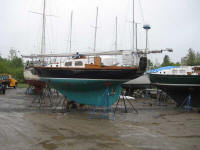
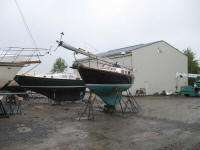 |
5/30/09
Launch day! I got a call
around noon from Ethan saying that the mast was up, and they
were planning to launch the boat on the high tide around
1600. This was good news, and the weather seemed
favorable for me to get the boat right around to her mooring
at Buck's Harbor, about 14 miles (by water) away.
I
arrived at the yard around 1530 to find the boat in the
slings and ready to go, so shortly thereafter they dropped
her in and I motored the boat out to a mooring so that I
could square away a few things: install the backstay,
install the roller furling genoa so that I'd have some form
of sail ready, install the boom to get it off the deck, and
install the dodger just because I thought with the
unseasonably cool temperatures and lateness of hour I'd be
grateful for its protection during the delivery. There
was a little wind from the SW, but not enough to consider
sailing into and still be able to complete the trip before
dark. Plus the boat wasn't ready to sail, and if I
took the time to rig her up properly it would take far too
much time. Getting the boat around to her mooring was
the priority for now: all business.
I headed
off the mooring at about 1630 into a bright and beautiful
day. Soon, though, some clouds to the west, which had
appeared benign as I started, suddenly took on a very
dangerous appearance. I hemmed and hawed about what to
do while I watched the still-distant clouds for a bit; I'd
only made it about a mile or so into the trip at this point.
Eventually, though, I determined that these clouds did
represent an immediate threat, and I saw no reason to push
on when the relative security of a good mooring was only a
short distance back. So with great reluctance, but
knowing it was the right thing, I turned around and headed
back to the mooring to wait out the storm. Even then I
knew it was likely that my chances of making the trip this
day were slim, as I'd simply run out of time to make the
trip before dark. I really didn't want to arrive in
full darkness; twilight would have been fine. With a
contrary current, I knew that I could only count on making
good about 4.5 knots, which would have made the trip tight
enough even on my original schedule. As I turned,
though, I could see some fog, which had been dangling well
offshore during my initial attempt, moving in quickly to
engulf the bay ahead, so this made the turn-around easier to
swallow. |
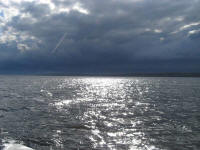
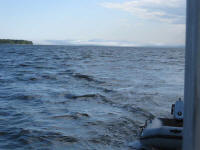 |
In any event, I made
it back to the mooring before the storm hit. I was
glad I had returned. The cloud formations were quite
dramatic: very distinct,
flat-bottomed-curved-leading-edged clouds forming a distinct
squall line. Within minutes of my return to the
mooring, the wind shifted and quickly built to an observed
high of 29 knots on my new wind instruments (more on this in
a moment), though the strongest winds only lasted perhaps a
minute before settling back to a non-event 15-20 max.
The heavy rain followed shortly thereafter, making its
appearance known beforehand with a white blankness to the
waters ahead of me. |
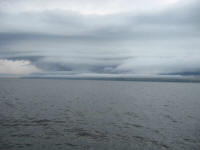
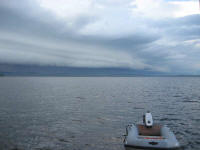
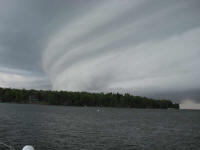
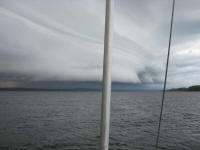
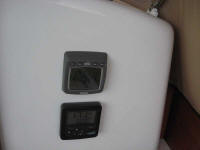
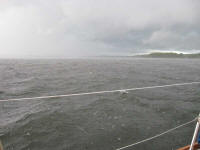 |
As with most summer
(sort of) storms of this nature, the event quickly passed,
leaving in its wake flat calm conditions and perfectly
bright, clear skies. By about 1815, I was extremely
tempted to head out on the delivery. My finger wavered
over the engine's start button. In the end, though,
caution won out. All along, I had kept the possible
contingency of simply staying on the boat overnight and
heading out in the morning in mind, and with what seemed to
be a favorable forecast for the next day I elected to wait.
The delay meant that I could spend the rest of the
evening getting the boat squared away. I really didn't
relish the prospect of heading down the bay with a partially
put-together boat, with only one sail rigged, but earlier
I'd been willing to accept this given the conditions, etc.
Now, however, I rigged up the mainsail, boom vang, and the
myriad other post-launch tasks that are required each
season, and which take several hours to complete.
I noticed that some
idiot installed the new masthead wind sensors upside down.
How annoying! The installer must have been rushing to
install the masthead units after a long road delivery in the
rain, and obviously got turned around somehow when standing
at the tiptop of a ladder screwing the thing into place when
the mast was horizontal and lying on the deck.
The
masthead might as well be on Mars to me, as it's just as
feasible for me to get to Mars as for me to get to the
masthead. Perhaps I'll locate some small person who is
anxious to be hoisted up my mast to fix this irritating
problem, but in any event the wind speed, at least, seemed
to work despite the cups being upside down and at a weird
angle. The direction was reversed on the display,
however. Plus, the masthead unit contains solar cells
on its (supposed) top side to power it; these cells were now
facing more or less downward, so I thought it'd be
interesting to see if they got enough juice for the season. |
|
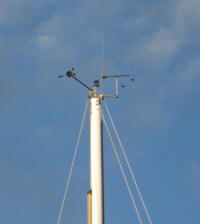 |
Afterwards, I settled
in to enjoy the calm, golden sunset and my first--if
unexpected--night on the boat this season. It was a
perfectly still, calm, cold night, and I looked forward to a
dawn start in the morning to get the delivery done and get
home to accomplish some other tasks. |
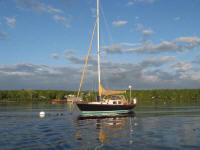
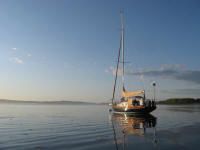
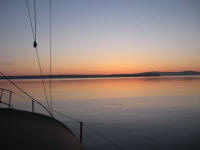 |
5/31/09
Overnight, I
awoke to the foghorn on the nearby Cape Jellison lighthouse,
right across the river from where I was moored. Yup:
thick o' fog. Somehow, I knew all along that this was
a distinct possibility this night, but there had been no
mention in the NOAA weather radio forecast. (That
should have been a virtual guarantee of fog right there,
shouldn't it've...)
I hoped it'd be one of those
temporary fogs that would either clear overnight, or soon
after dawn. But at 0500, it was extremely dense, so
with little else to do but wait it out, I began my vigil.
0600: dense fog. Where is the shoreline,
anyway? I wasn't even sure if I could dinghy ashore if
I had to, with few or nonexistent references visible in the
thick fog--there were only a couple other boats on moorings
in this cove, and I couldn't even see them.
0700:
dense fog.
0800: dense fog.
0900:
dense fog. Blue sky above--it was one of those
low-hanging fogs that forms just over the water.
1000: dense fog. Some hope, but man, this was
taking forever.
1050: Finally clear enough to
depart. I raised the main and tucked in the first
reef, even though there was only a little wind at this time,
but somehow I just knew the wind was going to end up being
fairly strong, even though NOAA was predicting something
like 5-10. Since when have they ever been remotely
correct in wind prediction anyway? I usually double
their predictions. Do they think they're doing people
a favor by underestimating wind strengths so routinely?
I hate NOAA for their poor forecasts, but it's all we have. |
 |
Almost immediately,
the wind built, and I unrolled the genoa and had the
beginnings of a great sail down the mouth of the river and
into the bay. At first, things were pleasant:
the wind, while fairly strong, was at least steady, and the
boat was doing pretty well under reefed main and partially
reefed genoa. Soon, I even unrolled the genoa the rest
of the way; the wind was 15-20 apparent. The direction
of the wind and the character of the waterway through which
I sailed was such that I could take long tacks in both
directions, but it wasn't clear that one tack or the other
was remotely favored: the wind could hardly have been
more from where I was going.
Of course, the
lateness of my departure meant that the flooding tide was
against me the whole way, reducing my speed towards
destination by 1-2 knots, meaning that I was seeing SOG in
the 4-5 knot range, mostly towards the lower end. The
reduction in over-ground speed was one thing, but as I
sailed into the top part of Penobscot Bay proper, leaving
the Penobscot River behind, the sea conditions became
unpleasant--mostly in terms of speed reduction and lack of
progress, not from a safety or discomfort perspective.
There were many moments of intense frustration with the
situation, between the headwind that meant that both tacks
seemed to take me away from the destination rather than
obviously closer to it, and especially the short, steep chop
and opposing current that had developed. There seemed
to be nowhere that was really clear from this current, so
all I could do was keep tacking back and forth across the
bay. Mostly, it was OK, but there were a few times
where the hobby-horsing of the boat really affected forward
progress. This is a trait that I find intensely
frustrating about this boat. I know that there is too
much weight in the ends, but where else am I to keep anchors
and all the other stuff? There are few options.
Whining aside, I'd say that I enjoyed 80% of the day's
sailing. I didn't enjoy the hours of pending and
waiting for the fog to clear, and I didn't enjoy sitting in
wave troughs going 2 knots after a tack. I also didn't
enjoy the idiotic pirate-ship thing (actually, more like
Slocum's Spray in appearance and size) that was powering
sail-less down the bay on a collision course with me and
showing no signs of giving way; what is it with these jerks?
This happens several times a season, and it makes me see
red. Rather than fuss around, I tacked away before the
situation became critical, but I didn't want to, and
shouldn't have had to either.
I took the picture
below early on in my journey, before I hit the frustrating
parts. There was neither time nor inclination for
further action photos during the remainder of the day. |
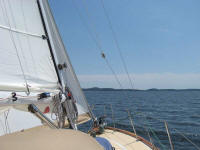 |
Finally, I made it to
a point where my tack would allow me to lay the end of Cape
Rosier; I intentionally overstood on the other tack so that
I could finally have a more enjoyable point of sail. Of
course, as soon as I passed the cape, and got inside the
islands just outside, what was going to be a nice close
reach suddenly ended, as the wind became light and fluky
within the shelter of the islands. My speed dropped to 3
knots; I was getting close to Buck's, and Heidi was supposed
to pick me up at 1600, and I was tired, and wanted to get
in, so I rolled in the jib and powered the rest of the way
(perhaps 3 miles). A copout perhaps, but enough was enough:
time to get in. Later, after I cleared some of the
islands, the wind picked up again (more from the SE in this
area of the bay), but by then I was nearly there, and didn't
bother sailing again.
I picked up my mooring at 1515 and put the boat to bed,
having sailed about 20 miles (OK, 20.15 exactly, if you must
know) to cover the 13.5 mile rhumb
line, plus 3.35 miles from yesterday's aborted attempt. I obviously hadn't properly prepared the interior for
sea, as there was lots of stuff on the cabin sole that had
come from the berths (understandable) and even one of the
side lockers, which had a catch that didn't work. I
dinghied ashore just in time for my ride and happy to have
the boat in the water, on her real mooring, and ready for
the season. I even beat the rain, which arrived not
long after we began the car ride home. |
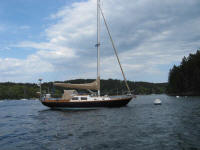 |
7/18/09
Almost
immediately after being pressed into service, the new sump
pump for the galley sink drain started to act up. I
found that the pump wasn't shutting itself off the way it
should have, forcing me to use a manual switch located in
one of the galley lockers. From the beginning, I
suspected the pump's sealed, non-mercury automatic switch.
In attempting to troubleshoot the pump and switch, my first
step was to check the basic operation of the pump. I
disconnected the discharge line from the pump chamber in the
bilge, and then pumped some water into the sink and allowed
it to drain into the chamber. Eventually, the auto
switch caused the pump to come on, authoritatively
discharging the chamber's contents into the bilge and then
shutting off properly. This performance led me to
consider whether the long, downhill slope of the discharge
line, which ran to the transom, was back-draining enough to
prevent the switch from properly sensing that the level had
dropped sufficiently.
My first attempt at a fix,
therefore, was to install a bronze check valve in the
discharge line, just downstream of the pump and chamber.
I located a suitable valve, one with a low activation
pressure, and installed it a week or two later when I was
back at the boat. It didn't work. (The
water looks particularly nasty in the bilge because it
contains the contents of the sump chamber, which I'd
necessarily discharged into the bilge. |
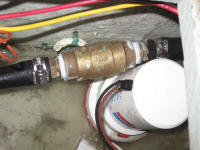 |
With good weather and sailing time so precious this
particular year, I didn't spend much more time on the
problem at that point. But when I came aboard for our
week-long cruise, the problem quickly became untenable:
the pump was running, but seemed to not even want to pump.
This led the chamber to overflow before I became aware of
the magnitude of the problem. Again, removing the
discharge line allowed the pump to work properly.
As soon as I could, I set to work on the pump to get
everything to work, since not having the sump working
properly was a serious problem; short term, I'd simply
allowed the dumb thing to pump into the bilge, so the bilge
pump could take care of it, but this obviously wasn't
acceptable as anything other than a stopgap. So with
rain on the first day of my cruise, I spent part of the
morning fixing it.
Thinking ahead, much earlier in
the season I'd brought aboard the old sump pump and
automatic float switch from my old sump chamber, which I'd
saved since they worked fine (I'd disposed of the old
plastic chamber because the top was broken and didn't seal
properly). I clipped the wiring connections and
removed the sump chamber from the bilge so I would work more
easily on it. I removed the pump and switch, and
cleaned up the chamber. |
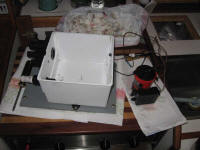 |
I decided to replace the sealed switch with my
old-fashioned (and functional) float switch, which was
straightforward enough. The float switch was rather
large, but fortunately there was enough room in the chamber
for it to fit properly and allow proper operation. I
secured it with one screw into one of the molded screw holes
left over from the original switch's installation, and then
reinstalled everything in the bilge--stopping just short of
making the installation final at this point, till I could
test the "new" switch.
Sure enough, the pump worked
flawlessly with the regular float switch, and continued to
work flawlessly throughout the week. While I was pleased
that the simple fix worked, I was annoyed at the poor
performance of the switch that came with the unit in the
first place. |
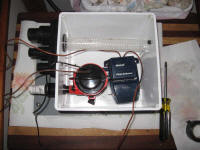 |
9/30/09
Another
brief season came to its end. But it was a pleasant
end.
Weatherwise, the season had been sort of all or
nothing: for June and July, the weather was
atrocious--colder than normal, rainy, and just not nice.
August and September, however, were beautiful months, and as
time allowed I managed a number of enjoyable daysails and a
very pleasant long weekend over Labor Day.
Inevitably, it became time to end the season, however.
I made plans to bring the boat up to a mooring at the
boatyard on Saturday, September 26.
As luck would
have it, this was a beautiful day, though it dawned quite
cold. With my sister along for the ride, we motored
the boat the 14.3 miles to the boatyard into a light
northerly headwind, though the wind died after an hour or
so, leaving a glassy calm. |
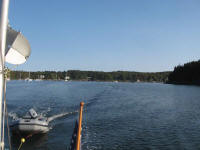
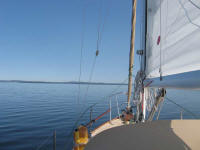 |
Once we arrived, right around 1120, I stripped the boat of
sails, boom, dodger, and whatever else needed to come off
before haulout. I'd always rather have a gorgeous day
when it comes time to end the season; though it's sad to
strip the boat down, and always seems a shame to waste a
nice day on this task, it is nicer to do it in pleasant
weather than the alternative. |
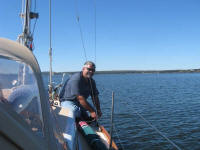
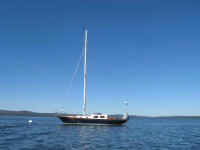 |
I had thought the yard was planning to haul the boat on
Saturday's late afternoon high tide--there was no one around
at the yard in mid-afternoon when we departed--but for some
reason I just had a feeling it wasn't going to happen.
Sunday was a lousy, rainy day with strong winds (fortunately
from the SE, which was a protected direction at Morse Cove),
and I didn't really worry about the boat, hoping she was out
(though somehow knowing she was still on the mooring).
As it turned out, the boat wasn't hauled till Tuesday
morning; the yard unstepped the mast and let me know the
boat was ready to pick up, so I drove up early Wednesday
morning, spent an hour and a half strapping down the mast,
preparing the boat, and loading her on the trailer, and then
drove home, arriving back at the shop just at noon.
I
didn't have much of a work list for boat during the
off-season, and with
other plans for my personal side of the shop, I set the
boat up on stands and blocks outdoors once more, where she'd
spend most of the winter. I anticipated bringing her
in for seasonal maintenance in early spring, and would
probably take care of some minor jobs in the meantime.
More on that later. |
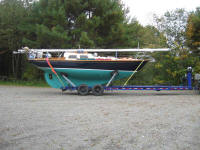
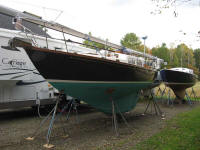 |
10/10/09 |
I spent
the day unloading the boat and winterizing. Once
again, I was amazed at the volume of stuff that I
removed--how does it all fit in this tiny boat?
I
removed most of the stuff from the lockers so that I could
once again sort through and cull out what was not needed
before reloading in the spring. For the moment, my
goal was to clear out the boat, so I didn't waste time or
energy on any semblance of unloading organization as I threw
things into plastic storage containers that I had left over
from something.
In the past, I'd stored most
of the boat stuff for the winter up in the attic in my
shop--2 flights of stairs up. This was exhausting and
annoying in both fall and spring, so this year I decided to
bring most of the stuff up to the house and store it in the
basement, where I'd be able to go through it in the coming
days to sort out what wasn't needed and to pack away what
I'd put back aboard in the spring. Since I could back
my truck right up to the basement door, this would save a
lot of labor both ways.
It took most of the morning
to remove everything; the boat was still fully loaded from
the season, with food, drink, clothing, and all the other
necessities of life aboard. Finally, I cleared away
all the excess, leaving me with an empty boat in which to
work.
I dug my old mast sawhorses out of the trees
and made some minor repairs to help see them through another
winter; I really needed to build some new ones, as these
original ones, built in 2001, were well-aged and becoming
rotten--but that wasn't going to happen now. I removed
all the rigging from the mast for storage, and then lifted
the mast up onto the storage horses on deck.
Next, I
winterized the engine, water system, and head--nothing new
or exciting here. I was already wishing that I could
put the boat back in the shop for the winter, as I noticed
all sorts of things that I wanted to do--high on the list
was my desire to remove the engine so that I could fully
renew the engine room, engine hoses, replace the engine
mounts (before they need it, not because they need it yet)
and the like (just because). But with no critical--or
even non-critical--need to do so, that would have to wait
for another time. Clearly, I need a bigger shop.
Or fewer boats. Or something.
It took so long
to do all this that I was unable to complete all the winter
storage tasks that I'd hoped to do. Still ahead I'd
need to remove the lifelines and stanchions, give the hull
and deck a good washing, and put on the winter cover.
I was hoping to do that tomorrow, as I was anxious to get
her buttoned up so that I could concentrate on
other things during my off-time.
I didn't have
much of a work list for Glissando this winter, with
the ever-present list of wishes but few actual requirements,
thanks to last winter's spa time indoors. Surely
things would crop up as I had more time to think about it,
but for now it looked like mostly regular maintenance
(varnish, cleaning, inspections) would be the extent of the
winter/spring work list. |
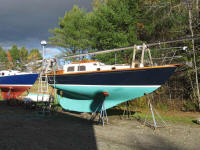 |
10/11/09 |
I
finished up the winter preparations by removing the
coamings, lifelines, and stanchions and taking care of some
final cleaning (inside and out, hull and deck). Then,
I installed my usual winter frame after wrapping chafe
points in foam and covering the mast in cotton sheets
to protect the paint and minimize chafe on the cover.
Finally, I installed the same silver tarp I'd used every
year since 2001, except for two years that the boat was
indoors during the winter(2003-4 and 2008-9). |
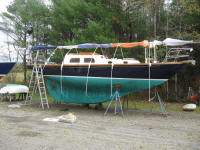
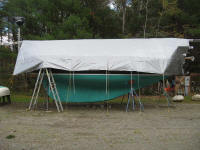 |
|